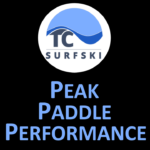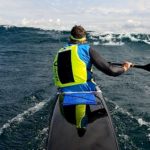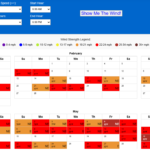The Challenge of Coming Up with Original Ideas
At least once a year I try to write a new post on downwind paddling, aka the surfing part of surfski. As I’ve now been writing for over five years, it is getting harder to come up with unique and beneficial ways of describing how to become a better downwind paddler, nevertheless I remain determined to try 🙂 I’ve been fortunate living in an area that delivers surfing conditions 5 out of 7 days a week all year (as long as your willing to brave the cold). I’ve continued to see improvements in my own downwind paddling, but realize that much of it likely occurs at a subconscious level and is not easily articulated. All that said, I do have some new thoughts and perspectives that I’m hopeful are original and will resonate with paddlers
It’s all about Flow
It can be said that downwind paddling is all about pattern recognition. Good downwind paddlers see recognizable patterns in front of them and anticipate what will develop and where to position their ski to take maximum advantage. Neuroscience proves that being in a flow state maximizes pattern recognition. And to be in a Flow state, you must be challenged but also within your abilities and not tense and nervous. This all equates to having a stable boat that you feel confident paddling in, a bullet proof remount so there is no fear of falling out, and conditions just big enough to challenge you. The more you are able to get into a Flow state, the better your subconscious pattern recognition will become. If you’re interested in learning more about FLOW check out this TED Talk from the Grandfather of Flow Mihaly Csikszentmihalyi. Mihaly has authored some amazing books. One of his originals, Finding Flow, remains one of my favorite reads of all time. Extremely basic, yet powerful and timeless. For a more modern and cutting edge view of flow, check out the Flow Genome Project the founders also have a new book titled Stealing Fire which is currently on my backlog list in Audible.
Mental Horsepower – Perhaps More Important than Physical
I’ve heard several of the top guys in the world talk about the mental exhaustion that can come from downwind racing. I mentioned in a recent blog that I did multiple laps through Swell City at the Gorge attempting to race Oscar Chalupsky who was giving tandem rides. In that short 1 km section, I quickly realized that one wrong decision and there was no chance of keeping up with Oscar. If you were to breakdown a downwind paddling session into % of decisions made right, Oscar is probably at about 99%. The rest of us lucky to hit 60% Looking at downwind paddling from a decision perspective, we are making hundreds of decisions every minute. For those who have logged thousands of hours downwind paddling most of these decisions are made at a subconscious level, but for those just starting out, this is conscious and can be exhausting. If you have ever bonked on a downwind run you’ve experienced first hand the dependency on cognitive function. It quickly becomes difficult to connect runs, I would argue more because of mental exhaustion and the inability to process the variables and make decisions, than the physical exhaustion.
How to Increase Mental Horsepower:
- Paddle a stable boat – It take a tremendous amount of mental horsepower to balance an unstable boat. Add the challenge of catching runs to the mix and I’m certain that most beginner and intermediate paddlers in unstable boats reach mental exhaustion long before physical exhaustion.
- Don’t allow your paddling buddies to distract you – This is much easier said than done, but even the slightest distraction is enough to take you significantly off your game in downwind paddling. If you are not very consciously aware, it is extremely easy to let the ego take control and ruin your downwind session as you muscle your way through the waves. But it almost never works.
- Fuel properly – this should go without saying, but it is especially critical before a downwind paddle that you are properly fueled. (Note: Being low carb adapted can be a benefit as your brain isn’t dependent on a limited supply of glucose to function optimally)
- Meditation – Downwind paddling is in itself a form of meditation, but if you find that you have a hard time staying focused, there is lots of science to demonstrate that mediation can improve focus. The beauty of meditation is that it is absolutely free and you can do it almost anywhere. But if you do need some structure and motivation to get started, Headspace has quickly become the go to app for beginning a meditation practice.
- Caffeine – is well proven to improve focus. The challenge here is to take advantage of the increase in focus while not letting it amp you up to a level where you try to power your way through the downwind. A very common combination to mellow the jitters of Caffeine is to combine it with the amino acid L-Theanine. I’ve never experimented with this combination for paddling, but if caffeine gives you the jitters, it may be worth a try.
- Nootropics – This is getting a bit more cutting edge, but there are now lots of different cognitive enhancing supplements on the market. Perhaps some of these could provide that extra level of mental clarity and quickness required to make more of the right decisions when going downwind. I’m hesitant to make any recommendations in this space, but google the term and your certain to find a lot of different recommendations. I do use a nootropic/cognitive supplement called Qualia on Monday’s when I need to get up at 3:30 AM to travel to work. It is quite effective for getting through the day, and while I would like to believe it is healthy with no long term side effects, I have no credentials to make that claim and I have never paddled while using this supplement so can’t speak to any benefits that it may offer for paddling.
We don’t know what we don’t know
I am more and more convinced that many of us simply don’t know what we don’t know. By that I mean, we can’t imagine how stable the pros (most of whom have grown up in K1s) are in their boats when paddling downwind and what this allows them to do. If you paddle an intermediate or advanced boat, imagine yourself in a V5 and this will give you a sense for how a pro feels in the V14, Nelo 560, Uno Max, Fenn Elite, etc.. Imagine that on a 10 mile downwind in runs in 4-5 foot waves, a pro will take several thousand strokes and not miss or apply limited power in a single one. No matter the position or angle of the boat in the waves, they can always take exactly the stroke they want to take. If you can’t do this, you are limiting your downwind paddling.
Understanding when the Tactics Have to Change
As I gain more experience in downwind paddling, I’m starting to see there is a threshold where the tactics needed to surf successfully change. I haven’t done enough paddling in different locations to know if the change is universal, but at my local paddle spot on Lake Michigan, there is a discnernable difference as the waves start to exceed around 3 1/2 feet in size.
3 foot and under – primarily just one rideable wave as opposed to having smaller slower waves mixed in with bigger and faster waves
- A strong paddler can usually paddle their way onto these waves with a solid effort so it is easy to get caught up in powering through the runs. But rather than doing this, take this opportunity to maximize the ride on each and every wave. Do this by experimenting with stopping your paddling earlier. You may miss a couple runs, but you are also sure to get some longer rides and most importantly you’ll develop more feel for when you are on the run. You should also hold back from starting to paddle as long as possible. Play with a change in angle or forward lean to keep the ride going longer. Notice in Boyan’s videos when he extends his paddle forward. This is allowing him to shift his weight ever so slightly to get just a little more time on the wave. A drill that Oscar advocates is to pair up with a buddy and count 50 strokes and see who gets the furthest. I typically paddle alone and am not a good multi-tasker so struggle to count strokes, but with a Vaaka cadence sensor I can easily analyze my distance per stroke afterwards to see if I’m making progress. Additionally you can target the ratio of speed versus HR to track your improvements over time.
- It is important to work the angles to avoid burying the nose whenever possible. Once on a run, it is a good practice to simply try and steer the bow wherever you can to avoid burying it. When it does look like you are going to bury the bow, push yourself back out of the bucket and lay on the back deck to shift more weight toward the back of the boat. This will substantially reduce the amount of pearling. Of course there are times when you just want to shoot straight ahead and that requires that you bury the bow, but keep the power on and push through it quickly.
- The concept of “drafting” (which I wrote about a couple of years ago) the wave by positioning the bow right behind the peak of the wave in front, works relatively well in waves 3 feet and under
- With a conscious effort, these waves can be surfed for a long time. I often find I can ride the smaller waves longer than the big ones.
Over 3 foot waves – A greater variation of small waves and big waves
- As the waves get above 4-5 foot, even strong paddlers will not be able to paddle directly onto them. Here you absolutely need to look for the smaller and slower waves and use them to build speed.
- Stay focused on surfing the easiest wave you can find and eventually your speed will build and a bigger opportunity will present itself.
- For those paddlers who commonly have smaller conditions this is one of the most difficult concepts to grasp. In small conditions you get used to being able to paddle your way onto the biggest wave you see. In bigger conditions you see the big waves and immediately want to do the same, but it just isn’t physically possible. Resist the urge!
- You will likely do more maneuvering in bigger waves as the wave direction is not as uniform
- In many situations you will need to catch the wave on the shoulder where it is smaller and easier to get on, then surf into the power zone. In this situation you square up perpendicular on the shoulder, then once on the wave, surf left or right into the power zone. (Oscar first described this to me in one of our podcasts, it took a while to sink in, but once it does, it becomes a go to maneuver)
- Looks for gates – as Boyan and Oscar have demonstrated in their amazing instructions videos, when coming off a big run, you’ll want to look for the “gates”. These are the intersections of the waves where the path is relatively flat and you can carry the momentum of the run just long enough for the next opportunity to present itself
- Keep a steady pace between runs – The bigger the conditions, the less you can afford to lose speed. If you’re not bracing on a run, you should be paddling. It doesn’t mean a hard effort, but just enough to keep the boat moving along until you find the next small run to catch.
Paddling a Tandem Downwind
Anyone who’s had a chance to paddle in the front of a tandem surfski downwind knows that this can be a very humbling experience. I’ve now logged 50 or so miles driving the tandem downwind, but still have a lot to learn. The tandem is a very different beast going downwind, and ultimately demands that you are patient and steady. It simply isn’t possible to accelerate and/or change direction on a whim as it is in a single. This can be a great experience to reinforce the concept of patience, gradually building momentum, and then leveraging that momentum once you have it.
Summary
One of the true joys of downwind paddling is that there is always something new to discover and more improvements to be made. It is truly a never ending journey. I hope this article has provided some new thoughts and ideas to keep your journey moving forward. As always, don’t hesitate to reach out to me with any questions, comments, or suggestions.



